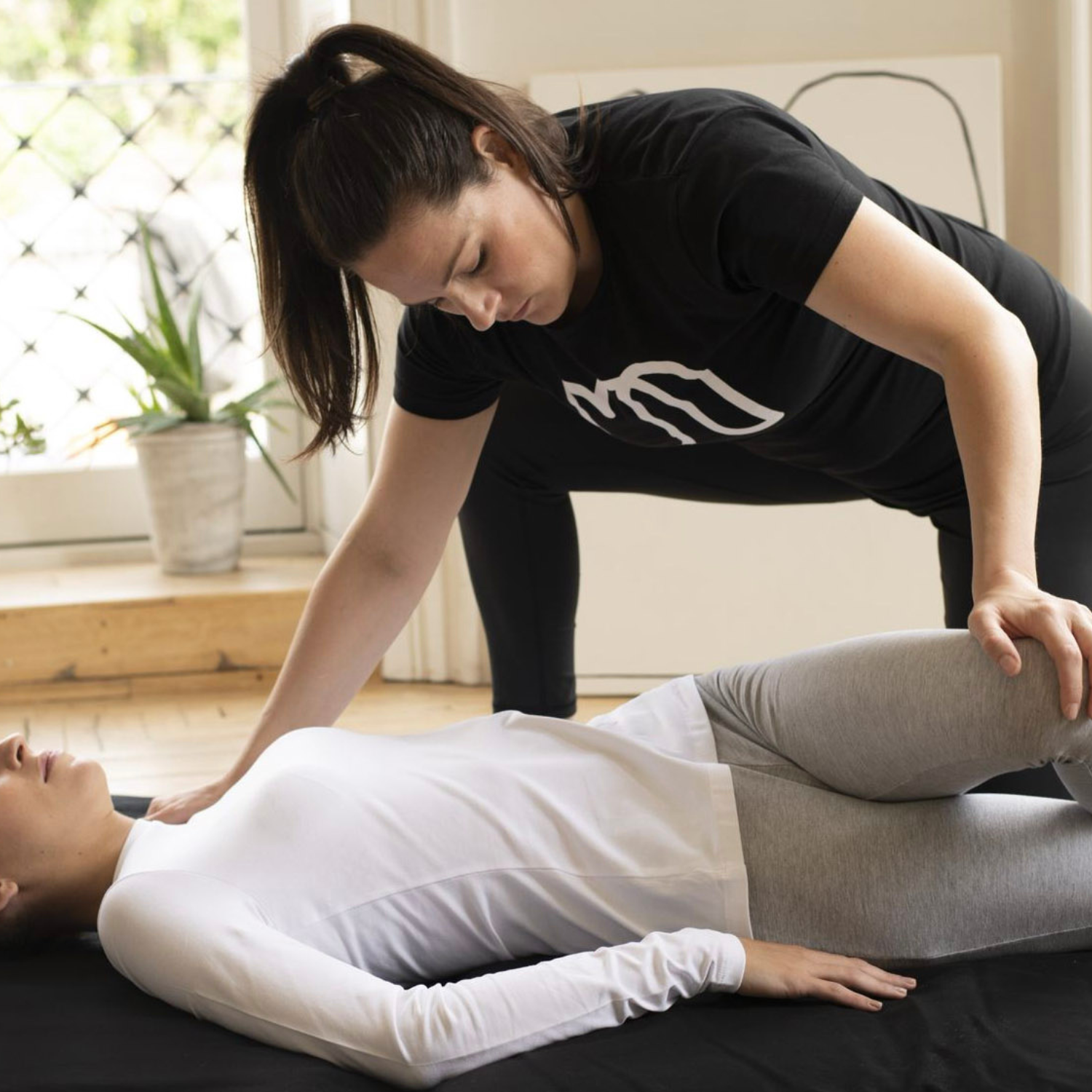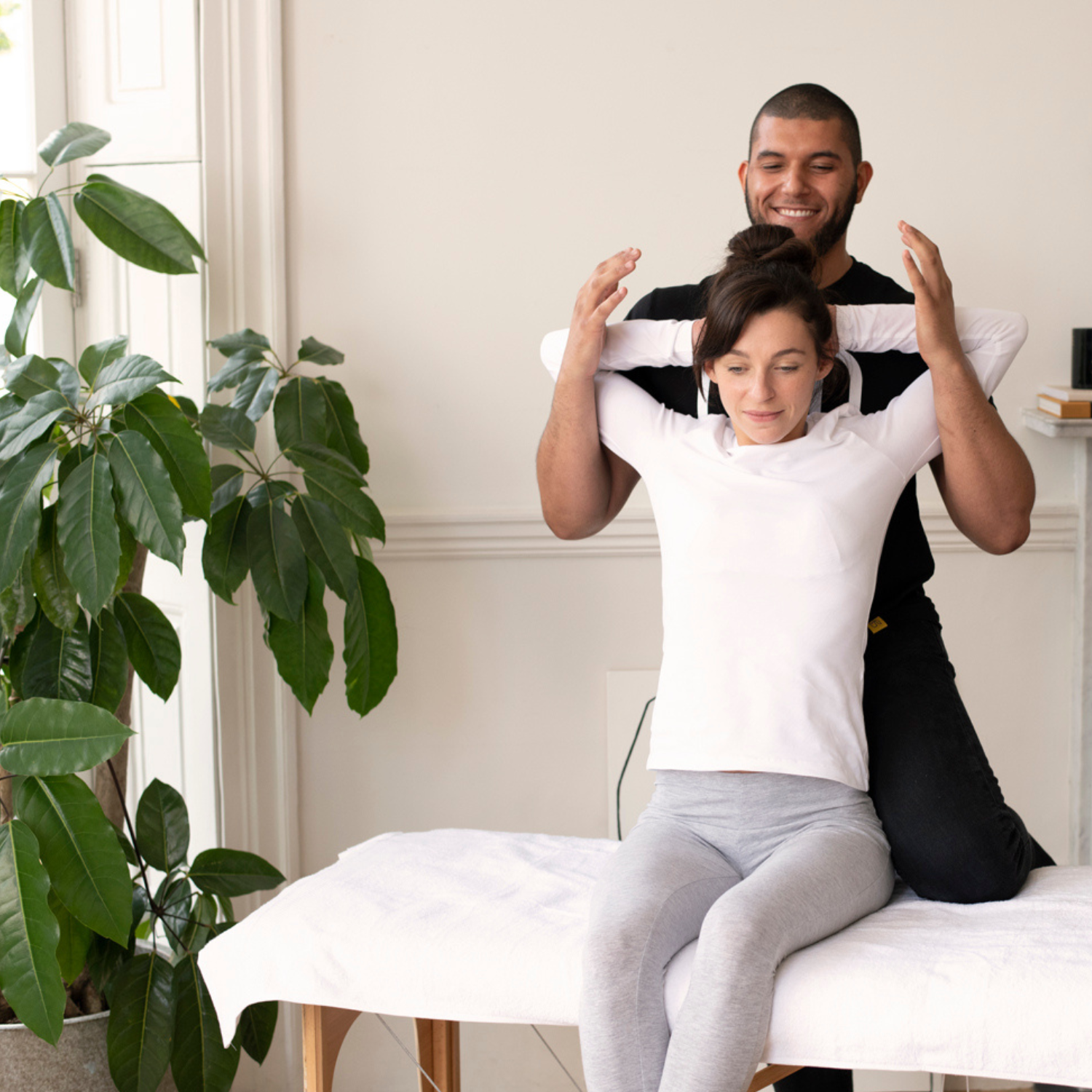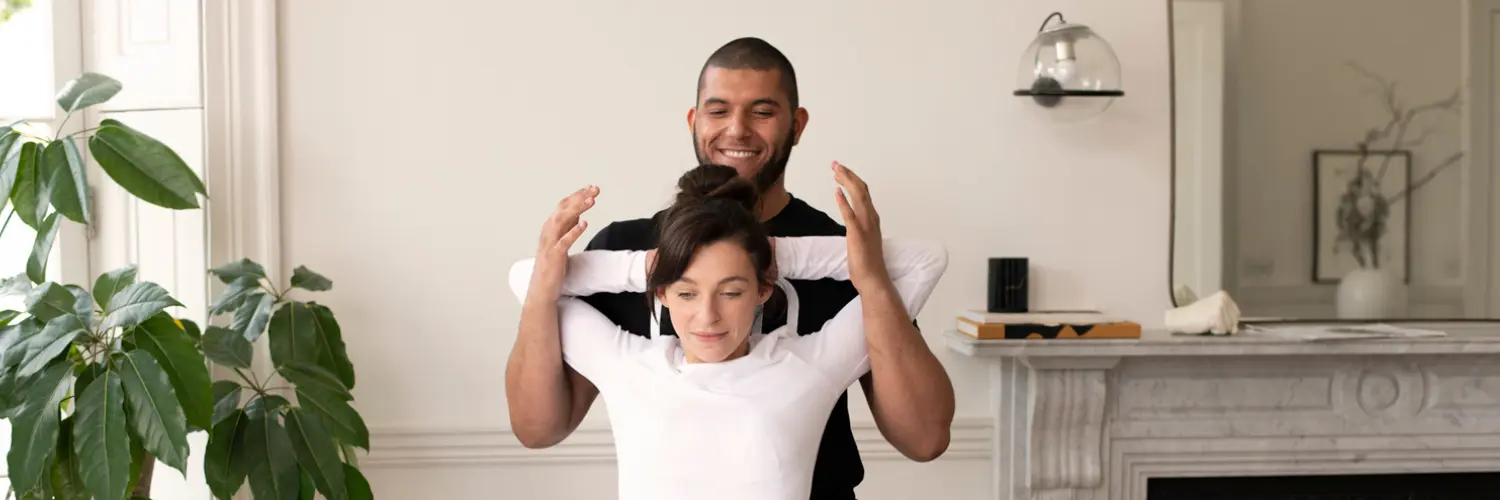What are the benefits of assisted stretching?
A deeper stretch than you can get alone
Increases flexibility and range of movement
Releases stress, feels amazing
Stretch your limits
not a muscle
If your daily routine sees you go from bed, to desk, to sofa, and back again with little movement in between, you’re not alone.
We often forget to stretch unless it's part of our workout routine, but stretching is just as important as brushing our teeth for our everyday health.
Booked regularly, assisted stretching is a tonic for both sedentary and active lifestyles, giving you a deep, satisfying stretch while avoiding injury.
What to expect during an assisted stretching session
Your stretch therapist will first ask you about what you’d like to achieve during the session and which areas you want to focus on.
After that, they'll guide you through a series of stretches using their body, hands, and feet to manipulate yours. If you've ever had a Thai yoga massage, you might recognise some of the techniques.
By the end of your session, you can expect to feel both energised and relaxed thanks to the boost in blood flow and endorphins that come with a great stretching session.
Assisted stretching FAQs
Assisted stretching is where an expert stretches your body for you, moving you into a series of positions to release muscle tension and keep joints healthy.
Designed for desk workers and athletes alike – and performed with you fully clothed – almost everyone can benefit from this low-effort, high-reward treatment.
Read a first-hand review of assisted stretching
It’s best to wear stretchy, comfortable clothing to keep you covered as your stretch therapist moves you through a range of positions. A long t-shirt and leggings/joggers is perfect.
We don’t recommend assisted stretching if you’re pregnant as certain stretches may not be safe during pregnancy.
Try our specialist pregnancy massage instead, suitable from your second trimester onwards.
If you’re not sure about whether assisted stretching is right for you, it's always best to check in with your doctor. It might not be right for you if:
You have a muscle or joint injury or for those with certain medical conditions such as osteoporosis, arthritis, or spinal cord injuries
For pregnant women as certain stretches may not be safe during pregnancy; try our specialist pregnancy massage instead
Assisted stretching has many proven benefits
Studies have shown that stretching helps with the range of motion and flexibility of muscles, both vital in preventing injury.
Better posture
Clients often say they feel taller after a stretch session and that’s because muscles lengthen when they’re stretched, allowing for more space in the spine and for shoulders to sit back rather than curl forward.
Reduced pain
If you’ve ever woken up with a stiff neck after sleeping in a funny position, you’ll know how painful restricted movement can be. Stretching can gently iron out the kinks, easing pain and freeing up movement. Researchers have shown that regular stretching (in this study, as often as five times a week) can be as effective as strengthening exercises in patients with chronic neck pain.
A boost of feel-good chemicals
Stretching boosts blood flow to the muscles along with oxygen and nutrients which makes it great for soothing delayed onset muscle soreness (DOMS). This burst of oxygen – along with mood-boosting endorphins and oxytocin – is why you feel so good after a stretch session.
Not only that, but when we’re stressed, we tend to tense up. A stretch session releases this built up tension, helping us feel calmer by activating our parasympathetic nervous system.
The benefits of stretching become even more valuable as we age
In one study, 20 women in their 70s were given a 10-week stretching programme. The results showed that static stretching of the trunk muscles significantly helped spinal mobility (back flexibility). In another, daily stretching exercises showed promise when it came to preventing falls by improving gait.
Yes! In fact, this is the perfect treatment if you want to work on your flexibility as your therapist will help you achieve a deeper stretch while avoiding injury.
If you work at a desk job, it’s normal to feel stiff and inflexible, but regular stretching helps you move more fluidly and develop better posture, among many other benefits listed above.
Assisted stretching is a brilliant treatment regardless of your fitness levels or lifestyle. It’s especially popular among people who spend a lot of time working at a desk as it helps address tight shoulders and ‘tech neck’.
It’s equally valuable for athletes and gym enthusiasts. It can help enhance performance by getting your key muscle groups working together properly, and with stretching out stiff and sore muscles post-exercise.
Your stretch therapist will bring a massage table with them. If you have a yoga mat, keep it to hand as it may be useful for certain stretches.
It’s best to book after a workout rather than before
Stretching after your workout helps you recover faster by flushing out metabolic waste, increasing blood flow, and lengthening the muscles that you've just worked.
Wait at least 24 hrs before exercising again
After an assisted stretching session, it's important to let your body rest and recover. Don't jump right back into any intense physical activity or exercise (wait a day or two). If there were specific muscles worked on in your stretch session, in your next workout you might want to exercise a different part of your body to allow these muscles to recover.
The main difference between assisted stretching and massage is the focus of the technique
Assisted stretching is mostly about improving flexibility and range of motion through the use of specific stretching techniques. Massage, on the other hand, is focused on promoting relaxation, reducing tension, and improving circulation through the manipulation of soft tissues.
Massage is performed directly on the skin, assisted stretching is clothed
Massage typically involves oil being massaged directly into the skin. Assisted stretching is an entirely clothed treatment, meaning you don’t need towels.
Massage and assisted stretching work well together
For overall muscle and joint health, massage and assisted stretching both have their place.
Assisted stretching can help you move more freely and fluidly, while massage can help to release tension and soothe muscle stiffness. When used together, these techniques make for a more thorough and effective treatment for muscle and joint issues.
Athletes and fitness enthusiasts might prefer to book assisted stretching more regularly than massage because of the way it loosens muscle tension instead of breaking it up.
To offer assisted stretching on Urban, therapists have to be qualified in at least level 5 sports massage, remedial massage or soft tissue therapy. Degree-qualified and registered osteopaths and physiotherapists also offer the treatment.
To prepare for an assisted stretching treatment, you should wear comfortable clothing that allows you to move easily, and avoid eating a heavy meal right before your session. It's also a good idea to communicate any injuries or areas of concern with your stretch therapist so they can tailor the session to your specific needs.
After an assisted stretching session, it's important to let your body rest and recover. Don't jump right back into any intense physical activity or exercise – wait at least 24 hrs.
Instead, take it easy and let your muscles recuperate. It's also a good idea to drink plenty of water and eat a nourishing meal to replenish your energy and give your body the nutrients it needs.
If there were specific muscles worked on in your stretch session, in your next workout you might want to exercise a different part of your body to allow these muscles to recover.
And finally, listen to your body – if you experience any discomfort or pain after the session, don't hesitate to follow up with your stretch therapist via the Urban app.


